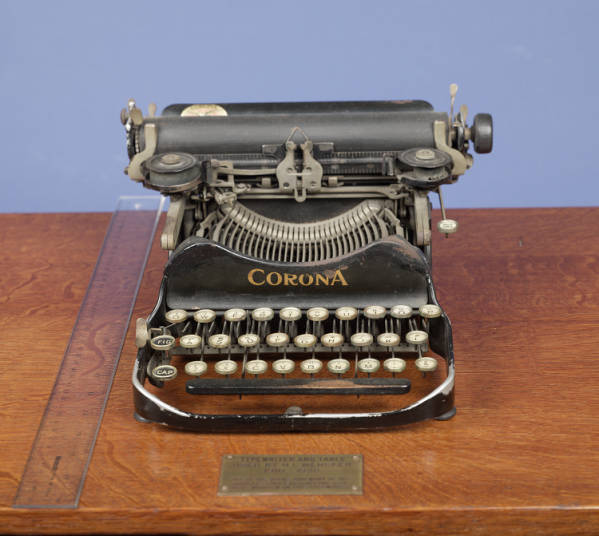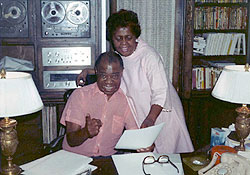 I belong to the first generation of biographers whose work was shaped by the invention of the personal computer. Not only did I write The Skeptic: A Life of H.L. Mencken on a computer, but I bought my first laptop in order to transcribe material from the Mencken Collection, which is housed in Baltimore’s Enoch Pratt Free Library. So far as I know, I was the first person ever to bring a laptop into the Mencken Room, whose contents include, among other fascinating things, the ancient Corona portable typewriter on which Mencken banged out most of his books and other published writings. I like to think that he would have appreciated this fact, but I wouldn’t bet on it. “The only modern inventions that have been of any real use to me are the typewriter and the Pullman car,” he told an interviewer in 1946. He didn’t even care for the telephone, and I have no doubt that he would have cast a cold eye on cellphones.
I belong to the first generation of biographers whose work was shaped by the invention of the personal computer. Not only did I write The Skeptic: A Life of H.L. Mencken on a computer, but I bought my first laptop in order to transcribe material from the Mencken Collection, which is housed in Baltimore’s Enoch Pratt Free Library. So far as I know, I was the first person ever to bring a laptop into the Mencken Room, whose contents include, among other fascinating things, the ancient Corona portable typewriter on which Mencken banged out most of his books and other published writings. I like to think that he would have appreciated this fact, but I wouldn’t bet on it. “The only modern inventions that have been of any real use to me are the typewriter and the Pullman car,” he told an interviewer in 1946. He didn’t even care for the telephone, and I have no doubt that he would have cast a cold eye on cellphones.
I finished writing The Skeptic on September 4, 2001, a week before 9/11. Blogging was uncommon then, and the Internet, though no longer in its infancy, was still in the process of evolving into the supple and protean research tool it has since become. I did almost no Web-based research on The Skeptic. Google existed in 2001, but I’d only just heard of it. Most of my work, as I explained in an online interview conducted in 2002, was done in the Mencken Room:
I spent the better part of five years sifting through the Mencken Collection at Baltimore’s Enoch Pratt Free Library, to which Mencken left most of his private papers–manuscripts, scrapbooks, cancelled checks, even one of the ancient portable typewriters he carted around to the presidential conventions he covered for the Baltimore Sun. It’s housed in a wonderful old room that looks like the library of a shabby but distinguished men’s club, and the walls are lined with books from Mencken’s personal library, many of them inscribed to him by people like F. Scott Fitzgerald and Theodore Dreiser. To sit in that room day after day, reading and writing about Mencken, was an extraordinary experience–sometimes I felt as though he were looking over my shoulder–and I also got a kick out of showing the collection to friends who happened to be passing through Baltimore.
All this was great fun, but it was also hugely time-consuming, so much so that I ended up renting a studio apartment in Baltimore, where I spent many three-day weekends during the five years it took me to research The Skeptic. I could have done some of my work in New York, but I found it easier to shuttle at will between the Mencken Room and the stacks of the Pratt Library, running downstairs at regular intervals to flip through dusty copies of the Readers’ Guide to Periodical Literature or spool through a reel of microfilm. (Remember microfilm?)
Everything had changed by the time I got going on Rhythm Man: A Life of Louis Armstrong four years ago. While I put in a fair amount of time at the Armstrong Archives in Queens and the Institute of Jazz Studies in Newark, I did much of my research on Rhythm Man seated at my desk in Manhattan, using my iBook to access the archives of the New York Times, The New Yorker, Time magazine and many other publications on line and on CD-ROM. Between them, Google Book Search and Amazon’s “Search Inside” feature also made it possible for me to look through more than half of the books I consulted without going to a library. I even “visited” Armstrong’s grave from the comfort of my office.
 Needless to say, there is no substitute for on-the-spot research. As I wrote two years ago: “To be sure, microfilm and its successor technologies are (mostly) unmixed blessings, but any scholar can tell you that there’s no substitute, emotionally speaking, for handling the thing itself, be it a scrapbook or a holograph manuscript. Though constant use has drained the word awesome of much of its meaning, I don’t know any other way to describe what it feels like to turn the crumbling pages of the personal scrapbooks of the greatest of all jazz musicians.” And while I suppose I could have written the following paragraph from Rhythm Man without first visiting Armstrong’s home in Queens, it wouldn’t have been the same had I settled for taking a virtual tour of the house and grounds:
Needless to say, there is no substitute for on-the-spot research. As I wrote two years ago: “To be sure, microfilm and its successor technologies are (mostly) unmixed blessings, but any scholar can tell you that there’s no substitute, emotionally speaking, for handling the thing itself, be it a scrapbook or a holograph manuscript. Though constant use has drained the word awesome of much of its meaning, I don’t know any other way to describe what it feels like to turn the crumbling pages of the personal scrapbooks of the greatest of all jazz musicians.” And while I suppose I could have written the following paragraph from Rhythm Man without first visiting Armstrong’s home in Queens, it wouldn’t have been the same had I settled for taking a virtual tour of the house and grounds:
[Armstrong’s] home, located seven blocks from Shea Stadium in a shabby but respectable part of Queens…is a modest three-story brick-covered frame house whose interior is reminiscent of Graceland, Elvis Presley’s gaudy Memphis mansion. From the Jetsons-style kitchen-of-the-future to the silver wallpaper and golden faucets of the master bathroom, the house looks like what it is: the residence of a poor boy who grew up and made good. Unlike Graceland, though, Armstrong’s house is neither oppressive nor embarrassing. As you stand in the smallish study, whose decorations include a portrait of the artist painted by Tony Bennett, it is impossible not to be touched by the aspiration visible wherever you look. This, it is clear, was the home of a working man, bursting with a pride that came not from what he had but what he did. “I never want to be anything more than I am, what I don’t have I don’t need,” he wrote. “My home with Lucille is good, but you don’t see me in no big estates and yachts, that ain’t gonna play your horn for you.”
But I’m also well aware that without making extensive use of Web-based research, I couldn’t have written Rhythm Man while simultaneously serving as The Wall Street Journal‘s drama critic. I simply wouldn’t have had the time. And Web-based research is more than merely a time-saving tool: it allows the biographer to act instantaneously on serendipitous flashes of inspiration. The night before I finished writing the last chapter of Rhythm Man, I found myself wondering whether Jerry Herman had ever said anything in print about Armstrong’s recording of “Hello, Dolly!” A few keystrokes later I found out that he had, and that it was both significant and revealing. I immediately transcribed the quotation and incorporated it into the manuscript that I e-mailed to Harcourt three days later.
Still, it is the time-saving aspect of Web-based research that I suspect most biographers will regard as crucial to their professional lives. It took me ten years to write my Mencken book. That’s a big chunk out of the life of a middle-aged man, big enough to make him think twice about going back to the well a second time. When I finished The Skeptic, I was sure that I’d never write another primary-source biography. But I did, and it took me just four years to write. That’s a lot more manageable, even for a busy drama critic and part-time opera librettist.
So what next? Another biography? A second opera? Or something completely different? I haven’t a clue. Now that the Web has cut out so much of the hitherto-inescapable waste motion of a biographer’s life, it would seem a shame for me not to build on the things I’ve learned in the process of writing Rhythm Man. But I don’t yet have a subject in mind, nor do I know what I want to do with the rest of my life, other than enjoy it.
What I do know is that I don’t intend to spend it sitting around idly–I’m not made that way–and experience has taught me that I’m rarely content to be doing only one thing at a time. Henry James said it: “Live all you can; it’s a mistake not to. It doesn’t so much matter what you do in particular as long as you have your life. If you haven’t had that what have you had?” I’ve had a lot, probably more than most people, in the seven crowded years that have whizzed by since I finished writing The Skeptic. Do I really want to spend four of the years that remain to me writing yet another primary-source biography? We’ll see.
